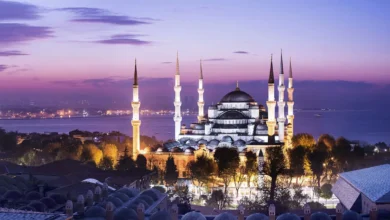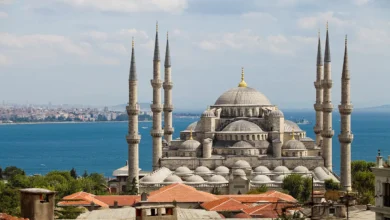
Hagia Sophia, located in the heart of Istanbul, is a true marvel of architecture, symbolizing the rich cultural and religious history of the city. Originally constructed in 537 AD as a Byzantine cathedral under Emperor Justinian, it was the largest church in the world for nearly 1,000 years. Following the Ottoman conquest of Constantinople in 1453, the building was converted into a mosque, adding Islamic architectural elements, including minarets and calligraphy. In 1935, Hagia Sophia was secularized and transformed into a museum, only to be re-designated as a mosque again in 2020. This rich and multifaceted history makes Hagia Sophia an iconic symbol of both religious and cultural diversity, drawing millions of visitors each year.
The Hagia Sophia Grand Mosque stands as a captivating landmark in Istanbul, blending Byzantine Christian elements with Islamic influences. This UNESCO World Heritage Site reflects the city’s unique position as a crossroads of cultures and religions. Visitors can marvel at the building’s grandeur, from the awe-inspiring dome to its mosaics depicting Christian iconography and Islamic calligraphy. With its storied past and stunning architectural features, Hagia Sophia continues to be one of Istanbul’s most celebrated and visited monuments.
Historical Background

Construction and Early History
Conversion into a Mosque

Museum Status
In 1935, after the founding of the Republic of Turkey and the implementation of secular reforms by Mustafa Kemal Atatürk, Hagia Sophia underwent another significant transformation. The decision was made to convert the mosque into a museum, symbolizing the Republic’s commitment to secularism and modernism. This move was intended to present Hagia Sophia not as a religious space, but as a cultural and historical monument that could be appreciated by people of all faiths.
As a museum, Hagia Sophia became a major tourist attraction, drawing millions of visitors each year. It provided a unique opportunity to witness the harmonious blend of Byzantine Christian mosaics and Islamic calligraphy, illustrating Turkey’s rich cultural heritage. This period as a museum allowed Hagia Sophia to be recognized globally as a symbol of Turkey’s diverse history.
Architecture and Design
Byzantine Architecture

Islamic Influence
Upon its conversion into a mosque, Hagia Sophia underwent significant renovations to accommodate Islamic worship practices. The addition of minarets, mihrab (prayer niche), and minbar (pulpit) incorporated elements of Islamic architecture while preserving the building’s original Byzantine features. This fusion of styles symbolizes the cultural exchange and religious tolerance prevalent in the region.
Interior Features
The interior of Hagia Sophia is adorned with stunning mosaics, calligraphy, and marble panels, showcasing the artistic achievements of both Byzantine and Islamic civilizations. The mihrab, adorned with intricate Islamic calligraphy, serves as a focal point for Muslim worshippers, while the Christian mosaics depict scenes from the life of Jesus Christ and the Virgin Mary, reflecting the building’s diverse religious history.

Cultural Significance
Religious Importance
Hagia Sophia has served as a key religious site for over 1,500 years, holding profound significance for both Christians and Muslims. Originally constructed as a Christian cathedral, it was the center of the Eastern Orthodox Church and a place of pilgrimage for Byzantine Christians. With its transformation into a mosque after the Ottoman conquest in 1453, Hagia Sophia became a symbol of Islamic faith and a focal point for Ottoman Muslims. Despite these transitions, the building has always been a place of worship, embodying the religious diversity and tolerance of Istanbul and, by extension, Turkey. The coexistence of Christian mosaics and Islamic calligraphy within its walls highlights its unique role as a bridge between two major world religions.
Symbol of Empires
Hagia Sophia’s status as a symbol of imperial power is integral to its identity. As the principal church of the Byzantine Empire, it stood as a manifestation of the empire’s religious and political strength. Its conversion into a mosque under the Ottoman Empire further cemented its role as a symbol of the Ottomans’ dominance and grandeur. In the modern era, under the secular Republic of Turkey, it continues to represent the historical significance of these empires. Throughout its history, Hagia Sophia has not only been a religious symbol but also a reflection of the ambitions and aspirations of successive civilizations, embodying the enduring legacy of both the Byzantine and Ottoman empires

UNESCO World Heritage Site
In 1985, Hagia Sophia was inscribed as a UNESCO World Heritage Site, recognizing its exceptional value to humanity. This designation highlights the building’s architectural innovation and its role as a testament to the cultural and religious history of both the Byzantine and Ottoman empires. UNESCO’s recognition of Hagia Sophia ensures that it remains preserved for future generations to admire and study. The site’s combination of religious and cultural influences, spanning over 1,500 years, makes it one of the most significant landmarks in the world, celebrated for both its artistic and historical contributions
Controversies Surrounding Hagia Sophia
Political Implications
The status of Hagia Sophia has been a subject of controversy and debate, particularly regarding its use as a mosque or museum. Political tensions and nationalist sentiments have often influenced decisions regarding the building’s management, leading to heated debates and protests both domestically and internationally.
International Response
The reconversion of Hagia Sophia into a mosque in 2020 sparked condemnation from various countries and religious organizations, citing concerns about religious freedom and cultural heritage preservation. The decision prompted diplomatic tensions and calls for dialogue and reconciliation to address the complex historical and religious sensitivities associated with the site.

Recent Developments
Reconversion into a Mosque
In July 2020, Turkish President Recep Tayyip Erdoğan announced the reconversion of Hagia Sophia into a mosque, reversing its status as a museum, which had been in place since 1935. The decision sparked a wide range of reactions both within Turkey and internationally. Supporters of the move viewed it as a reaffirmation of Turkey’s Islamic identity and a return to the building’s original purpose. However, critics expressed concerns over its potential impact on interfaith relations, as well as the cultural and historical integrity of the site. The decision to reconvert Hagia Sophia into a mosque was seen by some as politically motivated, creating tension in the context of Turkey’s relationships with Christian and secular communities.
Impact on Tourism
The reconversion of Hagia Sophia has had mixed effects on tourism. For some, the mosque’s return to its religious function has enhanced its appeal as a major site of Islamic worship, attracting Muslim visitors who come to pray and experience its spiritual significance. However, the controversy surrounding the move has raised concerns about its impact on the site’s role as a cultural and historical monument. Some tourists, particularly those interested in its Byzantine mosaics and architectural features, may feel uncomfortable visiting a mosque, given the restrictions on viewing certain aspects of the interior, especially during prayer times. Additionally, the shift has prompted debates about the balance between preserving Hagia Sophia as a cultural heritage site and maintaining its status as a functioning mosque

Conclusion
Hagia Sophia’s rich history and cultural significance make it a symbol of religious diversity and architectural brilliance. From its origins as a Christian cathedral to its transformation into a mosque and museum, it has witnessed centuries of political, cultural, and religious change. Despite the controversies surrounding its status, Hagia Sophia Grand Mosque serves as a powerful symbol of Istanbul’s complex history. Throughout the centuries, it has adapted to the changing tides of empires and religions. Today, it stands as a testament to human achievement in architecture, a reminder of the importance of tolerance and understanding across cultures and faiths.
FAQs
- Who built Hagia Sophia and when? Hagia Sophia was built under the commission of Byzantine Emperor Justinian I in the 6th century, starting in 532 and completed in 537. It was initially constructed as a cathedral and became a mosque after the Ottoman conquest of Constantinople in 1453
- Can non-Muslims visit Hagia Sophia? Yes, non-Muslims can visit Hagia Sophia. Although it is a mosque, it remains a popular tourist destination. Visitors are welcome to explore the site during designated visiting hours
- Is there a dress code for visitors? Modest clothing is required for entry. Visitors should avoid wearing short shorts, tank tops, or revealing outfits. Women are also expected to cover their heads.
- What are the visiting hours? Hagia Sophia is open to visitors from 9:00 AM to midnight, with a break for cleaning between 7:30 and 9:00 AM. The mosque is temporarily closed for worship during prayer times on Fridays.
- How do I get to Hagia Sophia? Hagia Sophia is located in the Sultanahmet district of Istanbul. The easiest way to reach it is by tram (Bağcılar-Kabataş line, get off at Sultanahmet stop), or by bus from various parts of Istanbul.





